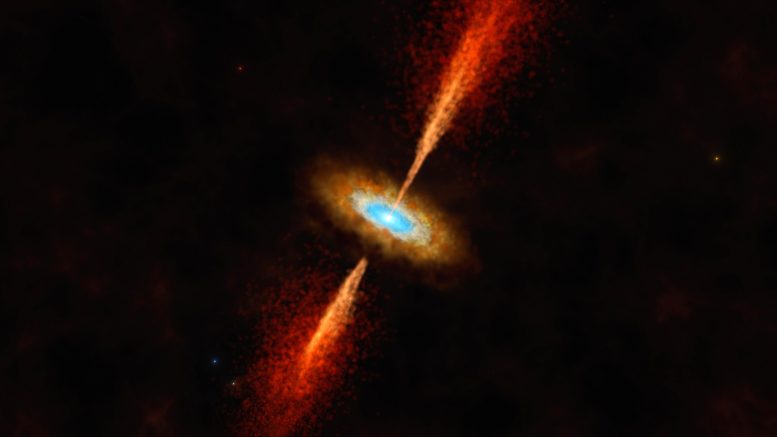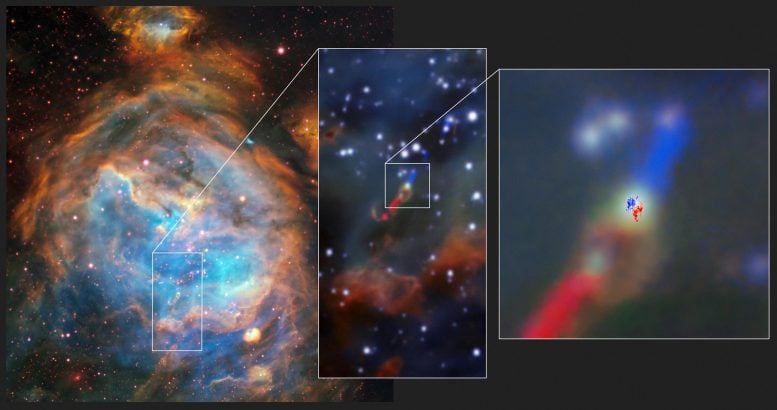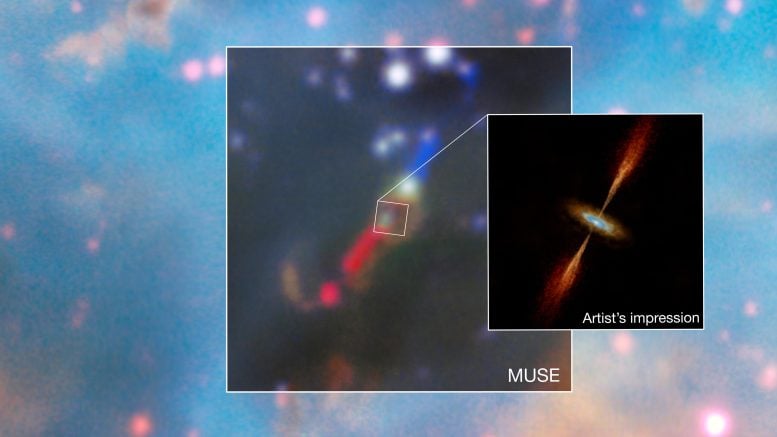Astronomers have discovered a rotating disk around a forming high-mass star in the Large Magellanic Cloud, marking the most distant such observation. This discovery, made using the ALMA observatory and detailed in Nature, reveals key differences in the star formation process in different galaxies, highlighting the lower dust and metal content in the Large Magellanic Cloud compared to our Milky Way. Credit: ESO/L. Calçada
A groundbreaking discovery by astronomers reveals a rotating disk around a high-mass star in the Large Magellanic Cloud, offering new insights into star formation in different galactic environments.
An international team of astronomers has reported the first detection of a rotating disc structure around a forming high-mass star outside of our Milky Way in another galaxy.
The disc surrounds a young massive star located in a stellar nursery called N180, residing in a neighboring dwarf galaxy called the Large Magellanic Cloud.
At a distance of 163,000 light-years from Earth, this is the most distant disc around a massive star ever to be directly detected.

This artist’s impression shows the HH 1177 system, which is located in the Large Magellanic Cloud, a neighboring galaxy of our own. The young and massive stellar object glowing in the center is collecting matter from a dusty disc while also expelling matter in powerful jets. Credit: ESO/M. Kornmesser
Groundbreaking Observations With ALMA
Using the Atacama Large Millimeter/submillimeter Array (ALMA) in Chile, in which the European Southern Observatory (ESO) is a partner, researchers observed motions in gas around a young stellar object in the Large Magellanic Cloud consistent with a Keplerian accretion disc – the kind that feeds the growth of stars through infalling material.
Led by Durham University and including astronomers at the UK Astronomy Technology Centre, the team’s findings have been published in the journal Nature.
As matter is pulled towards a growing star, it cannot fall directly onto it; instead, it flattens into a spinning disc around the star. Closer to the center, the disc rotates faster, and this difference in speed is the smoking gun that shows astronomers an accretion disc is present.

With the combined capabilities of ESO’s Very Large Telescope (VLT) and the Atacama Large Millimeter/submillimeter Array (ALMA), in which ESO is a partner, a disc around a young massive star in another galaxy has been observed. Observations from the Multi Unit Spectroscopic Explorer (MUSE) on the VLT, left, show the parent cloud LHA 120-N 180B in which this system, dubbed HH 1177, was first observed. The image at the center shows the jets that accompany it. The top part of the jet is aimed slightly towards us and thus blueshifted; the bottom one is receding from us and thus redshifted. Observations from ALMA, right, then revealed the rotating disc around the star, similarly with sides moving towards and away from us. Credit: ESO/ALMA (ESO/NAOJ/NRAO)/A. McLeod et al.
Insights From the Lead Researcher
Lead author of the study, Dr. Anna McLeod from the Centre for Extragalactic Astronomy, Durham University said: “When I first saw evidence for a rotating structure in the ALMA data, I could not believe that we had detected the first extragalactic accretion disc; it was a special moment.
“We know discs are vital to forming stars and planets in our galaxy, and here, for the first time, we’re seeing direct evidence for this in another galaxy.
“We are in an era of rapid technological advancement when it comes to astronomical facilities.
“Being able to study how stars form at such incredible distances and in a different galaxy is very exciting.”

This mosaic shows, at its center, a real image of the young star system HH 1177, in the Large Magellanic Cloud, a galaxy neighboring the Milky Way. The image was obtained with the Multi Unit Spectroscopic Explorer (MUSE) on ESO’s Very Large Telescope (VLT) and shows jets being launched from the star. Researchers then used the Atacama Large Millimeter/submillimeter Array (ALMA), in which ESO is a partner, to find evidence for a disc surrounding the young star. An artist’s impression of the system, showcasing both the jets and the disc, is shown on the right panel. Credit: ESO/A. McLeod et al./M. Kornmesser
Characteristics and Implications of the Discovery
Massive stars, like the one observed here, form much more quickly and live far shorter lives than low-mass stars like our Sun.
In our galaxy, these massive stars are notoriously challenging to observe and are often obscured from view by the dusty material from which they form at the time a disc is shaping around them.
Unlike similar circumstellar disks in the Milky Way, this system is optically visible, likely due to the lower dust and metal content of its surrounding environment. This gives astronomers a peek into the dynamics of accretion that are typically hidden behind veils of gas and dust.
Analysis of the disc suggests an inner Keplerian region transitioning to infalling material at larger distances from the central star. The star is estimated to be around 15 times the mass of our Sun.
While bearing many familiar characteristics of Milky Way discs, some intriguing differences also emerge.
The low metal content typical of the LMC seems to make the disc more stable against fragmentation.
The successful detection of this extragalactic circumstellar disc boosts prospects for finding more such systems with ALMA and the upcoming Next Generation Very Large Array (ngVLA).
Studying star and disc formation across different galactic environments will help complete our understanding of stellar origins.
For more on this discovery, see Astronomers Uncover a Planet-Forming Disc in Another Galaxy.
Using ALMA, astronomers have for the first time found a disc around a young star outside our own galaxy. This video summarizes the discovery. Credit: ESO
Reference: “A probable Keplerian disk feeding an optically revealed massive young star” by Anna F. McLeod, Pamela D. Klaassen, Megan Reiter, Jonathan Henshaw, Rolf Kuiper and Adam Ginsburg, 29 November 2023, Nature.
DOI: 10.1038/s41586-023-06790-2

Dr. Thomas Hughes is a UK-based scientist and science communicator who makes complex topics accessible to readers. His articles explore breakthroughs in various scientific disciplines, from space exploration to cutting-edge research.








